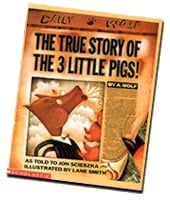| The True Story of the Three Little
Pigs |
Next |
About the Book
Before Reading the
Book
Classroom
Activities
About
the Book
 Although
just about all of us think that we know the story of the three little
pigs, in this comical picture book, A. Wolf clears up some misunderstandings.
According to A. Wolf, we simply have not heard his side of the story
— until now. While we may believe that the wolf who visited
the three little pigs huffed and puffed to blow the pigs' houses
down, it turns out that he simply had a bad cold and had a powerful
sneeze. Who could blame him for eating the pigs that died when their
houses fell as a result of his sneezing? Furthermore, the wolf was
only visiting the pigs in the first place to borrow a cup of sugar
to make a cake for his grandmother's birthday. The pigs wouldn't
even give him any sugar! When the third pig insulted his grandmother,
A. Wolf "got a little crazy." The police found him trying to break
down the pig's door, and news reporters wrote the story that we
have come to know. Although
just about all of us think that we know the story of the three little
pigs, in this comical picture book, A. Wolf clears up some misunderstandings.
According to A. Wolf, we simply have not heard his side of the story
— until now. While we may believe that the wolf who visited
the three little pigs huffed and puffed to blow the pigs' houses
down, it turns out that he simply had a bad cold and had a powerful
sneeze. Who could blame him for eating the pigs that died when their
houses fell as a result of his sneezing? Furthermore, the wolf was
only visiting the pigs in the first place to borrow a cup of sugar
to make a cake for his grandmother's birthday. The pigs wouldn't
even give him any sugar! When the third pig insulted his grandmother,
A. Wolf "got a little crazy." The police found him trying to break
down the pig's door, and news reporters wrote the story that we
have come to know.
Before
Reading the Book
A Traditional Tale?
Before reading The True Story
of the 3 Little Pigs!, ask for volunteers to tell the traditional
story of the three little pigs. Let the volunteers take turns telling
parts of the story. Then read The True Story of the 3 Little Pigs!
together with your class. Ask students to fold a piece of paper
in half. On one side of the paper, they should make a list of what
parts of this story are different from the traditional story. On
the other side of the paper, they should make a list of what parts
of the story are the same.
Classroom
Activities
Point of View
In this retelling of the three little pigs, the author changes
the point of view of the story. Usually readers sympathize with
the pigs. Here, readers hear the wolf's side of the story. Ask students
to write about whether or not they are convinced by the wolf's version
of the story. Does he seem trustworthy? Why or why not?
A Letter to A. Wolf
Ask children to write a letter
to A. Wolf in jail. Have them think about what more they would like
to know about this wolf. What questions would they like to ask him
about what happened to the pigs?
Read All About It!
Although The True Story of the 3 Little Pigs! is funny, it does
make the point that two different newspapers might cover the same
story differently depending on who their readers are and on what
those readers believe. For example, A. Wolf's story appears in The
Daily Wolf. The other news reports (that tell the story of the big
and bad wolf) appear in The Daily Pig. The wolf paper and the pig
paper seem to print the stories so that their own kind come out
looking good. Ask students to write about the story of the three
little pigs as if they had watched nearby when the wolf visited
each of the pigs. Their stories can appear in a newspaper called
The Daily Human. Have students think about how would the story change
if the police were human. Would it become a story about human beings
instead of pigs? (For example, would the story be headlined "Police
Save Pig"?)
Act It Out!
Choose two groups of four students to act out the different
versions of the Three Little Pigs. Ask the first group to act out
the story as it's usually told-they may want to reread one of the
versions of the traditional story before they begin. Have them write
out what they will say during each of the three scenes-when the
wolf visits the pig in the straw house, when the wolf visits the
pig in the stick house, and when the wolf visits the pig in the
brick house. Then, ask the second group to act out The True Story
of the 3 Little Pigs! Have the rest of the children in the class
write about what they liked in each performance, and how the performances
were different.
More Fairy Tale Fun
Ask children to think about
other fairy tales that might change if they were told from a different
point of view. For example, how would The Daily Wolf cover the story
of Little Red Riding Hood? How would Cinderella's stepsisters tell
her famous story? How would Snow White's stepmother explain what
happened to her? Have children write their own versions of famous
fairy tales with a twist.
Fractured Fairy Tale Message Board
Once your students have completed some of the activities above,
you can have them publish their work online.
|